
Smart TV Market Analysis by Mordor Intelligence
The smart TV market size stands at USD 263.7 billion in 2025 and is projected to reach USD 301.4 billion by 2030, expanding at a 2.71% CAGR. Momentum now comes less from first-time ownership surges and more from incremental improvements such as AI-driven picture processing, integrated cloud-gaming features and value-chain localization that compresses costs while preserving margins. India’s expanded production-linked incentives and similar manufacturing credits in Vietnam and Mexico are fostering near-source assembly hubs that shorten lead times and lower average selling prices Ministry of Commerce & Industry. Display makers are steering R&D toward Mini-LED backlighting and quantum-dot enhancements that counter OLED’s supply constraints, while telecom operators bundle televisions with fiber plans to widen addressable households. Platform competition is shifting toward ad-supported content services and extended software-support promises, encouraging premium replacements even in mature regions.
Key Report Takeaways
- By resolution, HD/Full HD held 37.8% revenue in 2024, whereas 8 K UHD is forecast to grow at 4.2% CAGR to 2030.
- By screen size, the 46-55 inch bracket commanded 32.1% of the smart TV market size in 2024; sets above 65 inches are poised for a 3.8% CAGR.
- By screen shape, the Flat TV segment commanded 90.8% of the smart TV market size in 2024; Curved TV sets are poised for a 4.9% CAGR.
- By panel technology, LED/LCD retained 61.9% share in 2024, while Mini-LED shipments are advancing at 3.1% CAGR.
- By operating system, Android TV led with 34.2% share in 2024; proprietary platforms collectively expand at 3.2% CAGR.
- By distribution channel, offline retail accounted for 69.8% of the smart TV market size in 2024, yet online sales grow the quickest at 5.1% CAGR.
- By geography, Asia-Pacific led with 41.2% smart TV market share in 2024 and is also the fastest-growing region with a 3.2% CAGR through 2030.
Global Smart TV Market Trends and Insights
Drivers Impact Analysis
| Driver | (~) % Impact on CAGR Forecast | Geographic Relevance | Impact Timeline |
|---|---|---|---|
| Price erosion of 55-65″ 4 K sets | +0.80% | India, Brazil, wider APAC | Medium term (2-4 years) |
| Telecom-led fiber roll-outs | +0.60% | Indonesia, Thailand, Malaysia | Long term (≥ 4 years) |
| Government PLI & localization incentives | +0.50% | India, South Asia | Medium term (2-4 years) |
| FAST-channel integration | +0.40% | North America, EU | Short term (≤ 2 years) |
| Cloud-gaming partnerships | +0.30% | Global developed markets | Medium term (2-4 years) |
| Matter-certified interoperability | +0.20% | EU, North America | Long term (≥ 4 years) |
| Source: Mordor Intelligence | |||
Price Erosion of 55-65″ 4 K Sets Accelerating Mass Adoption in India and Brazil
Chinese OEMs pushed 55-inch 4 K retail pricing below USD 400 in 2024, a threshold that once signaled the premium tier. Aggressive promotions, such as TCL’s drop on 98-inch models from USD 5,999 to USD 1,999, compelled rivals to broaden entry-level line-ups while preserving margins through localized sourcing . Samsung’s Indian unit still reported INR 10,000 crore television revenue in 2024, underscoring that brand-led AI features can hold price points even amid deflation Lower barriers entice middle-income households into larger-screen categories and compress replacement cycles across value-sensitive markets.
Telecom-Led Fiber Roll-outs Catalyzing First-Time Ownership in Southeast Asia
Nationwide fiber plans in Indonesia, Thailand and Malaysia are shrinking broadband subscription costs and enabling seamless 4 K streaming. Operators now bundle entry-level 43-inch televisions with 100 Mbps contracts, creating integrated service propositions that sidestep traditional retail channels. As viewing shifts from mobile devices to living-room screens, addressable demand moves beyond urban cores into tier-2 cities, sustaining outperformance against the global smart TV market through 2030.
Government PLI and Localization Incentives Lowering ASPs in India
New Delhi widened electronics incentives to INR 22,919 crore in 2025, drawing INR 59,350 crore pledged investment for display modules and boards. Domestic output jumped from INR 1.9 lakh crore in FY 2015 to INR 9.5 lakh crore in FY 2024. The same framework funds India’s USD 9.2 billion semiconductor program, closing component gaps and trimming logistics costs. Together, these moves cut delivered pricing on mid-range models by up to 12% in 2025, widening the smart TV market without eroding manufacturer profitability.
Integration of FAST Channels Spurring Upgrade Demand in North America
Free ad-supported streaming television (FAST) now commands prime-time parity with cable among U.S. adults. Xumo research shows more than half of viewers aged 18-44 relying on FAST services. OEM platforms such as Samsung TV Plus and LG Channels invest in exclusive channel packaging, nudging households toward newer sets with expanded storage and enhanced audio. Advertiser demand funds continual UI improvements, making platform capabilities-not panel specs-the tipping factor in the replacement decision.
Restraints Impact Analysis
| Restraint | (~) % Impact on CAGR Forecast | Geographic Relevance | Impact Timeline |
|---|---|---|---|
| Low-cost streaming dongles | -0.50% | Emerging, price-sensitive markets | Medium term (2-4 years) |
| Semiconductor tightness for Mini-LED backlights | -0.40% | Global premium tiers | Short term (≤ 2 years) |
| Fragmented OS ecosystem | -0.30% | Global | Medium term (2-4 years) |
| EU Tier-2 energy rules for 8 K | -0.20% | Europe | Long term (≥ 4 years) |
| Source: Mordor Intelligence | |||
Semiconductor Tightness for Mini-LED Backlights Limiting Premium Supply
Mini-LED sets need thousands of driver ICs and densely packed diodes; wafer-fab capacity for these parts lagged surging demand in 2024. TrendForce estimates Mini-LED television shipments grew 59% to 6.4 million units in 2024, overwhelming available component supply. Lead times stretched beyond 30 weeks, prompting brands to prioritise flagship lines and delay mid-tier adopters. Supply relief hinges on new 12-inch fabs slated to ramp only in late 2026.
Low-Cost Streaming Dongles Extending Replacement Cycles in Price-Sensitive Markets
Roku, Fire TV and Chromecast sticks add streaming capability to legacy panels at under USD 50, giving households a budget path to OTT content. The devices update faster than display hardware, so consumers upgrade accessories rather than entire TVs. This dynamic particularly affects the entry-level smart TV market in Latin America and South-East Asia, where discretionary incomes remain tight. In response, TV makers now highlight longer software-support windows and exclusive cloud-gaming tie-ups to justify set-level upgrades.
Segment Analysis
By Resolution: 8 K Premium Positioning Gains Momentum
HD/Full HD still led revenue with 37.8% in 2024, sustained by cost-sensitive buyers in developing economies. Conversely, 8 K UHD is projected to compound at 4.2% and outsprint overall smart TV market growth through 2030. Samsung’s Vision AI engine, rolled out in 2025, enhances lower-resolution streams to near-native 8 K quality and mitigates the shortage of ultra-high-bitrate content . EU ecodesign rules that limit peak brightness add pressure to engineer more efficient backlights, nudging brands toward Mini-LED over OLED for high-nit compliance.
Entry-level 4 K sets inherit premium features such as variable-refresh-rate gaming modes, blurring the mid-tier and expanding the total smart TV market. Content platforms also upscale catalogues to HDR10+ and Dolby Vision, reinforcing demand for higher-pixel-density panels that can render dynamic metadata accurately.

Note: Segment shares of all individual segments available upon report purchase
By Screen Size: Large Format Drives Premium Revenue
Mainstream 46-55-inch models captured 32.1% of the smart TV market in 2024. Average selling prices in this category fell 9% year on year after local assembly scaled in India and Mexico. Sets above 65 inches are forecast for a 3.8% CAGR and pull most premium technology attach-rates, including 120 Hz panels and object-tracking sound.
Manufacturers leverage shared glass-substrate fabs to push 98-inch LCDs below USD 2,000, making wall-sized viewing accessible to middle-income households. Pandemic-era home-theatre upgrades reconfigured living-room layouts, and those spatial changes now lock in preference for larger screens. Smaller than 32 inch remains viable for secondary rooms, yet the revenue mix shifts upward, underpinning profit pools despite moderate headline growth for the smart TV market.
By Panel Technology: Mini-LED Challenges OLED Dominance
LED/LCD technology delivered 61.9% unit share in 2024 because its mature supply chain keeps costs low. Mini-LED backlighting, however, is growing at 3.1% and is set to overtake OLED volumes in 2025, helped by quantum-dot layers that improve colour volume. LG Display’s annual OLED output plateaued near 10 million panels, capping broader expansion.
Mini-LED offers peak brightness benefits that ease EU energy-efficiency compliance and unlock advanced HDR formats without the burn-in risk of emissive stacks. Brands also tout thinner optical stacks and smaller bezels, achieving near-OLED aesthetics at lower bill-of-materials. Panel allocations thus hinge on wafer-fab availability rather than consumer preference, tying technology adoption to broader semiconductor-capacity decisions.
By Screen Shape: Flat Panels Dominate Despite Curved Innovation
Flat TVs accounted for 90.8% of all shipments in 2024 because wall-mount versatility and multi-seat viewing remain decisive factors. Curved displays, expected to grow 4.9% CAGR, stay niche but profitable in gaming rooms where peripheral-vision immersion matters. Cloud gaming services running at 120 Hz give curved models a marketing hook, especially when paired with ultrawide aspect ratios.
Installation rigidity and furniture mismatch restrain broader uptake. Manufacturers experiment with radius values that reduce glare and ergonomic strain, yet only a subset of enthusiasts values the experience to pay the premium. Hence, curved screens serve as halo products that elevate brand perception without strongly altering the unit-mix of the smart TV market.
By Operating System: Android TV Leads a Fragmented Landscape
Android TV delivered 34.2% global share in 2024, offering developers a single code base and ingrained Google services. Proprietary stacks-Tizen at 12.9%, VIDAA and webOS close behind-grow collectively at 3.2% as vendors pursue data monetization and UI differentiation.
Samsung pledged seven years of Tizen upgrades for 2024 models, easing consumer fears over software depreciation. App makers nevertheless face high QA costs maintaining parity across at least five major platforms, nudging some to prioritise HTML5-based streaming channels. Voice assistants and AI-powered content discovery become battlegrounds, converting operating systems from mere middleware into revenue engines for the wider smart TV market.

By Distribution Channel: Online Growth Challenges Retail Dominance
Physical stores retained 69.8% of revenue in 2024 because many buyers still want to gauge picture quality firsthand. Yet pure-player and omni-channel sites grew 5.1% CAGR and lured value hunters with flash sales and integrated installation scheduling. High-resolution video demos, AR-enabled room-fit visualisers and next-day white-glove delivery chip away at showroom advantage.
Walmart’s USD 2.3 billion purchase of Vizio illustrates how retailers now covet first-party operating systems to monetise post-sale advertising. Direct-to-consumer portals from Xiaomi and TCL capture retail margins and harvest usage analytics, sharpening iterative product planning for the smart TV industry. As logistics reliability improves, e-commerce is set to narrow the channel gap further, even for 85-inch crates.
Geography Analysis
Asia-Pacific generated 41.2% of 2024 revenue and leads growth at 3.2% CAGR as domestic panel fabs in China and assembly hubs in India lower regional landed costs. New Delhi’s incentive ecosystem boosted local output nine-fold over a decade, creating scale that reverberates across ASEAN exporting corridors. Fiber roll-outs and OTT content localisation bring first-time buyers in Indonesia, Vietnam and the Philippines into the smart TV market, expanding rural penetration.
North America is mature; replacement demand hinges on AI-powered upscaling and FAST-channel integration. Advertiser-funded services subsidise premium sets, and cloud-gaming latency improvements elevate refresh-rate specifications. Europe wrestles with stringent energy-efficiency law EC 2024/1781 that caps brightness for large 8 K models.[1]Source: European Parliament and Council, “Regulation (EU) 2024/1781,” eur-lex.europa.eu Compliance forces thinner peak-luminance levels, prompting Mini-LED adoption and spurring R&D into micro-lens arrays.
Middle East and Africa trail with low single-digit penetration, yet infrastructure investments and rising disposable incomes signal headroom. Regional broadcasters rolling out Arabic-language FAST channels remove content barriers. Latin America shows bifurcated demand: premium sets sell into affluent urban districts, while low-cost streaming dongles slow panel upgrades in price-sensitive households. Throughout, currency volatility steers manufacturers toward flexible sourcing and hedging strategies to keep the smart TV market competitive.

Competitive Landscape
Samsung has remained the volume leader since 2006, holding roughly 28% global unit share by combining in-house panels, semiconductors and Tizen OS stewardship. Vision AI launched across 2025 OLED, Neo QLED and Micro-LED lines, using on-device neural engines to tailor picture and sound in real time. [2]Samsung Research, “CSA Releases Matter 1.3 Specification and SDK for Smart Home IoT Standardization,” research.samsung.comTCL and Hisense counter with value pricing and government-backed financing that let them place Mini-LED hardware in mid-range SKUs.
Operating systems are now a focal battleground. Samsung’s seven-year upgrade pledge locks users into Tizen; LG extends webOS-based ThinQ services to appliances; Xiaomi integrates HyperOS to cross-sell IoT devices. Walmart’s control of Vizio’s SmartCast injects a retailer into the platform contest, mirroring Amazon’s Fire TV strategy. Advertising inventory and first-party data become profit drivers eclipsing traditional hardware margins, reshaping competitive incentives across the smart TV industry.
Strategic partnerships intensify: Samsung and Microsoft added Xbox Cloud Gaming onto 2024 sets, while LG teamed with Nvidia GeForce Now. Such tie-ups pull gaming-centric customers into higher-refresh displays and low-input-lag silicon, creating add-on revenue for content subscriptions. Matter 1.3 certification also narrows ecosystem fences, forcing brands to differentiate on AI, sustainability and long-term software support rather than proprietary connectivity. [3]Samsung Electronics, “Samsung Electronics Introduces Its Most Advanced TVs and Soundbars Yet, Powered by Vision AI,” news.samsung.com
Smart TV Industry Leaders
-
LG Electronics Inc.
-
Samsung Electronics Co. Ltd
-
TCL Electronics Holdings Limited
-
Xiaomi Corporation
-
Hisense Group Co., Ltd.
- *Disclaimer: Major Players sorted in no particular order

Recent Industry Developments
- March 2025: The Indian Cabinet cleared a INR 22,919 crore electronics component scheme aimed at boosting domestic display-module output and lifting value addition to 40%
- January 2025: Samsung unveiled its 2025 OLED line featuring Vision AI and 4 K 165 Hz QD-OLED panels
- December 2024: Walmart closed the USD 2.3 billion acquisition of Vizio, integrating SmartCast into Walmart Connect’s ad stack
- August 2024: Samsung guaranteed seven years of Tizen OS upgrades for 2024 models, covering more than 270 million installed units
Research Methodology Framework and Report Scope
Market Definitions and Key Coverage
Our study defines the smart TV market as revenues generated from factory-built televisions that embed an operating system, integrate Wi-Fi / Ethernet connectivity, and allow direct access to streaming, web, and smart-home applications without external dongles or set-top boxes. Legacy flat-panel sets that require an add-on device, hospitality displays, and commercial signage panels are left outside this boundary to keep our totals tightly linked to consumer living-room demand.
Scope exclusion: units retro-fitted with streaming sticks or external media boxes are not counted.
Segmentation Overview
- By Resolution
- HD/Full HD
- 4K UHD
- 8K UHD
- By Screen Size (Inches)
- Upto 32
- 33-45
- 46-55
- 56-65
- Above 65
- By Panel/Display Technology
- LED/LCD
- OLED
- QLED
- Mini-LED
- Micro-LED
- By Screen Shape
- Flat
- Curved
- By Operating System
- Android TV
- Other/OEM Proprietary
- By Distribution Channel
- Offline Retail (Hypermarket, Brand Stores)
- Online (E-commerce, D2C)
- By Geography
- North America
- United States
- Canada
- Mexico
- Europe
- Germany
- United Kingdom
- France
- Nordics
- Rest of Europe
- South America
- Brazil
- Rest of South America
- Asia-Pacific
- China
- Japan
- India
- South-East Asia
- Rest of Asia-Pacific
- Middle East and Africa
- Middle East
- Gulf Cooperation Council Countries
- Turkey
- Rest of Middle East
- Africa
- South Africa
- Rest of Africa
- Middle East
- North America
Detailed Research Methodology and Data Validation
Primary Research
Mordor analysts held structured calls with panel manufacturers, white-label assemblers, multi-brand retailers, and telecom bundle managers across Asia-Pacific, Europe, North America, and Latin America. These discussions clarified conversion rates from flat-panel output to smart-enabled sets, mapped regional ASP dispersion, and stress-tested forecast drivers such as replacement cycles and bundled fiber offerings.
Desk Research
We begin with public datasets on television production and trade from UN Comtrade, International Telecommunication Union broadband statistics, and the Consumer Technology Association shipment tracker, which provide volume anchors. Company 10-K filings, investor decks, and earnings calls supply realized average selling prices and regional mix. Trend insights on panel technology and capacity come from Display Supply Chain Association papers, while BloombergNEF and Statista dashboards help benchmark retail price swings. D&B Hoovers gives us revenue splits for leading OEMs. The sources mentioned illustrate our approach; many additional records were consulted during verification.
Market-Sizing & Forecasting
A top-down reconstruction converts global LCD/OLED TV shipments into smart-TV volumes using region-specific penetration ratios, which are then valued with weighted ASPs. Selected bottom-up checks, supplier roll-ups, and sampled retail audits tighten totals. Key model variables include household broadband subscriptions, panel cost curves, streaming-subscription penetration, GDP per capita, refresh-cycle length, and the shift toward larger screen sizes. Forecasts employ multivariate regression supplemented by scenario analysis to reflect income sensitivity and technology adoption curves, and gaps in localized bottom-up data are bridged with controlled interpolation from adjacent geographies.
Data Validation & Update Cycle
Outputs pass multi-step variance checks against historical shipment trends and independent retail indices; material anomalies trigger re-contact with interviewees before senior review sign-off. Reports refresh yearly, and any major industry event (e.g. tariff change, panel shortage) prompts an interim update so clients receive our latest vetted view.
Why Mordor's Smart TV Baseline Commands Reliability
Published estimates often diverge because firms pick different inclusion rules, pricing assumptions, and refresh rhythms. According to Mordor Intelligence, we align scope first, and then adjust for local ASP reality before applying disciplined forecast logic.
Key gap drivers include rival studies counting hybrid connected displays, rolling forward list prices rather than realized ASPs, or extrapolating one region's growth to all others without broadband or income controls, whereas our model nails region-level factors and benefits from an annual refresh cadence.
Benchmark comparison
| Market Size | Anonymized source | Primary gap driver |
|---|---|---|
| USD 263.7 Bn (2025) | Mordor Intelligence | |
| USD 227.5 Bn (2024) | Global Consultancy A | Includes streaming devices and applies uniform 4K premium across regions |
| USD 231.3 Bn (2024) | Industry Association B | Excludes platform-ad revenues; uses single shipment data source without ASP triangulation |
These comparisons show that Mordor's carefully bounded scope, region-tuned variables, and frequent updates yield a balanced baseline that decision-makers can trace, replicate, and trust.
Key Questions Answered in the Report
What is the current value of the smart TV market?
The smart TV market size is valued at USD 263.7 billion in 2025.
How fast will the smart TV market grow over the next five years?
Industry revenue is projected to reach USD 301.4 billion by 2030, translating to a 2.71% CAGR.
Which region offers the strongest growth prospects?
Asia-Pacific leads with a 3.2% CAGR through 2030, supported by cost-efficient manufacturing and expanding broadband access.
What technology segment is rising the fastest?
Mini-LED panels are advancing at 3.1% CAGR, set to overtake OLED shipments by 2025.
Page last updated on:



